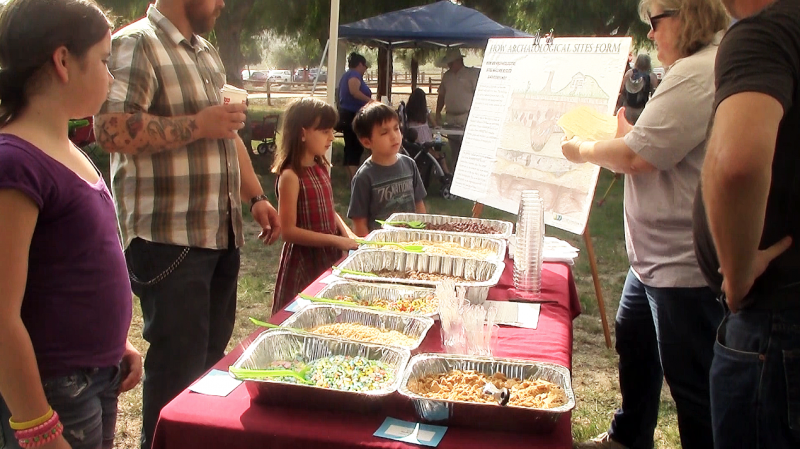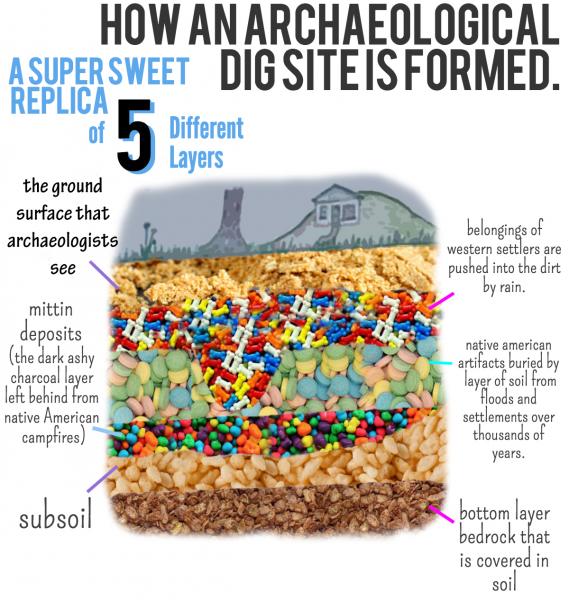SoCal Kids Investigate Their Interest In Archaeology

Archaeology Institute of America’s Riverside & Inland Southern California Society and Riverside County Parks held the third annual International Archaeology Day Expo last Saturday, an all day exposition held at the Hidden Valley Nature Center in Riverside California.
Over 450 people attended the free event, held on a hill that overlooked the scenic view of Hidden Valley Wildlife Area. While some of those visitors were the Boy Scouts of America working to earn their Archaeology and American Cultures Merit Badge, the majority of attendees were children from Southern California who met professional archaeologists and learned how archaeological investigators discovered the past.
The exposition had over two-dozen different exhibits conducted by archaeology organizations based in Southern California, filled with ancient artifacts and activities, teaching children how dig for ancient artifacts and how to identify what time era the artifacts came from.
The archaeologists of the exposition grabbed the attention of all ages by avoiding jargon and technical terms and creating hands-on activities like painting, molding and arrow shooting. The children who attended the exposition were given a “passport” as they walked in, and collected signatures from each exhibit after they recited what they had learned.
Anthropology professor Dr. Betsy Lawlor set up an archaeological investigation of a hearth, a place where food was once cooked, and asked the children to help her investigate what type of food was cooked. “This was designed for the children to give a description of what they see, sketch some of the main shapes of the remains, and compare them to our references,” Lawlor said.
Lawler’s investigative exhibit has several ancient campfire remains under a large magnifying glass, and a stand with a chart containing several references to previously discovered hearth remains. One of the children, an 8-year-old boy, said he saw “similar shapes of charcoal from vocation” and began to perform the same type of work Dr. Lawler teaches her students at Mt. San Antonio College.
L & L Environmental Inc. held a more “hands-on” activity to present their archaeological rock exhibit. “Rather than just showing pictures, we wanted to get the children involved in a hands on experience. They are sitting down and recreating some of the art that would have been done by some of the Native Americans who lived in Southern California, “ Leslie Irish, CEO of the organization, said.
Children placed a piece of charcoal inside a stone bowl called a metate. They then used a stone hand tool called a mano to pound the charcoal into a powder mixed with animal fat, using the same method used by the Native Americans to create pigments and paints. “The only difference is that we used lard instead of leftover fat of a hunted animal,” explained Irish. “We also tampered with the paint by adding glue so that the children could take home their art without a mess.”

Aside from recreating Native American rock art, children teamed up with archaeologist from the environmental consultation firm of ECORP Consulting, Inc. and made miniature dig sites they could eat.
Cultural Resources Manager Evelyn Chandler and her partner Brad Rockhold replicated a dig site with different candies and cereals so that the children could explain how archaeological sites form in layers of sediments created by nature and people. The children created the dig site in a plastic clear cup and dug their plastic spoons into each layer.
“This way the kids could eat through their layers to ‘excavate’ the artifacts that they find in the different strata,” Chandler said, referring to the many layers of earth or levels in an archaeological site.
The exhibits that did not involve handmade crafts or tasteful treats were just as eye-catching and informative.
Anthropology professor at University of Redlands, Wes Bernardini, introduced visitors to spear-throwing using an ancient device called an atlatl, used for warfare and hunting in the old world about thirty-thousand years ago.
“It replaced the simple spear, lengthening the arm and increasing the force of a projectile by about sixty percent,” Bernardini said. The children used an atlatl to toss spears at a hay-target about 30 yards away.
Another attention-grabbing display was a large, taped off empty area with a small camera drone at the center. Many of the visitors, both children and parents, said they had heard of drones, but they did not know why there was one at an investigative archeology expo.
Archaeologist William Hayden explained that he used his drone to create acurrate topographic maps of archaeological sites and monuments.
“If I wanted to create a map of a dig site, this drone will calculate the height you want the robot to fly at, and then it will fly around and take pictures every second to create a large detailed view of those hard-to-get-to places,” Hayden said.
The children were interested in how the device performs the tasks Hayden spoke about. One child repeatedly asked if Hayden “played” with the drone for his job.
Each of the diverse exhibits stirred up questions and curiosity in all of the visitors of the International Archaeology Day Expo. Rather than walk through dry lands of dig sites and explain archaeology with technical terms and jargon, the Archaeology Institute of America is getting kids interested in the study of the past with an interactive and memorable experience.
The Archaeology Institute of America’s Riverside and Inland Southern California Society and Riverside County Parks sponsored the free expo, with additional support from the Society for California Archaeology, the national office of the Archaeological Institute of America, and Inland Environmental Associates.










